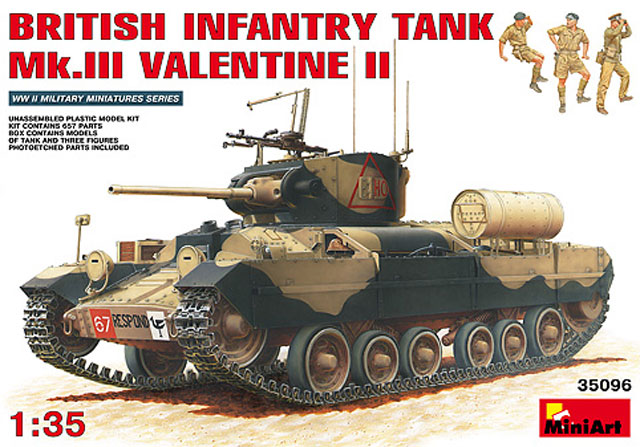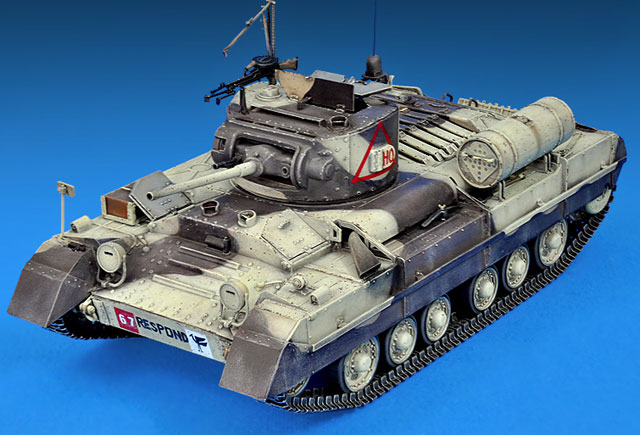|
|
|
|
| Home > Reviews > Britain > Miniart 1/35 scale Kit No. 35096; British Infantry Tank Mk. III Valentine II w/Crew |
British Infantry Tank Mk. III Valentine II w/Crew
Reviewed by Cookie Sewell

Summary
Catalogue Number: |
Miniart 1/35 scale Kit No. 35096; British Infantry Tank Mk. III Valentine II w/Crew |
Scale: |
1/35 |
Contents and Media: |
609 parts (555 in grey styrene, 54 etched brass) |
Price: |
USD$63.00 |
Review Type: |
FirstLook |
Advantages: |
Beautifully done model of this widely used Commonwealth vehicle; interior parts for turret and driver’s compartment; layout makes upgrading with aftermarket kits relatively easy |
Disadvantages: |
Single link tracks will be tedious to assemble |
Recommendation: |
Highly Recommended for all Commonwealth or Soviet armor fans |
FirstLook
The Valentine was one of those tanks that managed to provide both reasonably good performance with relative reliability, and as such was used by the Commonwealth as well as provided to the Soviets under Lend Lease. I leave it to true historians of British armour (with a U!) such as Peter Brown to provide a more detailed history of the vehicle, as most of my knowledge of it is based on Russian sources.
From their point of view it was a good tank. It was what they wanted for an “infantry escort tank” in the same class as the T-26: slow, reliable, possessing relatively heavy armor protection for its size, armed with a machine gun for “eliminating Hitlerists” and a useful gun for dealing with light armor, and as a bonus powered by a diesel engine. Their major faults with the vehicle were insufficient traction from its tracks and that unlike the Soviet 45mm 20-K gun its 2-pdr did not throw a “useful” high explosive round.
The Soviets got their first Valentines at the end of November 1941 and by the end of 1944 had received 3,332 of all models of the Valentine, which they dubbed the “MK III” in service (Matildas were MK II and Churchills MK IV, based on their British Infantry Tank designations). The numbers were 216 in 1941, 959 in 1942, 1,776 in 1943, and 381 in 1944. The tank provide so popular and flexible it was used across the western front and attempts were made to convert them into SP gun as the ZIS-95 with a 45mm antitank gun and a DT machine gun.
A number of years ago VM came out with a kit of the Valentine with 2-pdr (the actual version was a bit fuzzy) and also the later 6-pdr variant; at least the 2-pdr version and a “Bishop” self-propelled 25-pdr were offered by DML in their “Imperial” series of kits. Assembly was rough as fit was “optional” at best, but with some work it COULD be built as a Valentine.
Now Ukranian manufacturer Miniart has released a series of Valentine kits including one with a Russian crew; as this variant was not available and the Soviet ones were basically British models minus their skirts, I picked one up at the 2010 IPMS USA Region 2 show from a chap selling them below retail; later, I received a second one from MRC for review of their new product line.

I already knew that Miniart did a great job of their kits with only a few minor problems in the ones released so far, such as the turret in their T-70M and suspension alignment in the Su-76M. But as I had already heard fom British armor fans, Miniart did a magnificent job on these kits. While I had swapped parts of the first kit with Peter Brown for the parts to its companion Russian Lend-Lease version, this particular one provides the base Mark II tank with a crew of three British tankers in desert uniform and the desert oriented fender skirts and mudguards. It comes with two different mantlets (one – part D5 – is for another version of the tank as the directions do not indicate it is optional). The kit provides a very complete and complex 2-pdr gun with slide-molded barrrel and a very detailed Besa and breech assembly for the interior of the turret. Note that while the gun and a complete No. 19 Wireless Set (with etched brass “cage” parts) are provided no seats or crew “comforts” are provided.
The driver’s position is relatively complete with controls, panels, and seat, and both hatches may be posed open to show it. However, none of the crew members are posed to fit it.
The suspension is not as fiddly as the VM one was and does a nice representation of the variant of the “Slo-Mo-Shun” suspension used on Vickers designs. The small road wheels come with separate fronts and backs, and the large ones are in two parts with a separate tire. This is neater than some other options. Each driver consists of six parts to get the proper look. Even the springs – molded parts - are nearly flash and seam free.
However, each side takes 98 track links and these are small and come from sprues; cleanup and assembly will be tedious so prepare in advance for an evening or two on those. The good news is that the tracks fit well once the “nubs” are cleaned up, so at least none of them require the even worse filing and fiddling to assemble. Based on my experiences with them it would be a good idea to make a jig from a section of scrap plastic and a thick section of strip; this permits accurate horizontal and vertical alignment and making sections of 10 at a time for easier final assembly. The main thing here is to use a slow-setting plastic cement that provides flexibility for final adjustment during fitting to the model. (Note that the Canadian built ones used a high level of manganese in the tracks; they do not rust but acquire a brown patina through oxidation, so bright red rust finishing is not correct).
The rest of the model is pretty straightforward. One word of warning: this kit is closer to the Tristar efforts in that it requires precise fit and trimming to get the parts in place; “that’s close” will not work and cause a lot of frustration. I failed to get a clean assembly job on the turret hatch covers by not paying attention (another reason I was glad to get a second kit!).
All of the covers and shrouds on the engine deck are separate parts (again unlike the VM effort) and will give a great deal of depth to the finished model. However, etched brass parts are integral to the kit and thus require mandatory use; sorry DML fans, no options. These include brackets for the muffler guard, wing nuts for tool holders, and other tiny items. The photo etched parts are not backed by card as many other companies provide to ensure flat shipping, but are coated with adhesive film on both sides which seems to work well in protecting the parts.
The tank provides the “Heath Robinson” spring loaded antiaircraft mount for the Bren antiaircraft light machine gun, which consists of six parts. Oddly enough, the directions then show the Bren gun (which comes with a drum magazine and bipod) attached to the turret roof. Go figure. There is also a nice six part turret antenna mount.
The figures provide an officer and two other ranks with the officer in service cap with goggles and the other two with black berets. But as these figures are basically generic, there are no places or locations given for them with the vehicle. One is seated and the officer and other one are standing, but in positions which will make it difficult to fit into the turret. All was nicely sculpted and I personally rank the Miniart figures up there with DML and Masterbox.
A color booklet with finishing directions is provided for seven different vehicles: “Culloden”, C Squadron, 40th RTR, 23rd Armoured Brigade, July 1942 (sand, green 10); B Squadron, 40th RTR, 23rd Armoured Brigade, December 1941 (sand, white 6); “Mohawk”, C Squadron, 40th RTR, 23rd Armoured Brigade, December 1941 (sand, no number); “Cheetah”, C Squadron, 40th RTR, 23rd Armoured Brigade, September 1942 (sand with black patches, no number); “Respond”, A Squadron, 50th RTR, 23rd Armoured Brigade, Tunisia 1942 (sand with black patches, red HQ); “Viking”, Regimental HQ, 23rd Armoured Brigade, Spring 1942; and captured tank, unknown unit (sand, black crosses on skirts, registration number T27414). A nice sheet of decals is provided for these options.
Overall this appears to be a nice series of kits and already both a “Bishop” and a 17-pdr “Archer” have been hinted at as well as other variants. Good job, Miniart! (Note: the price may seem high, but in a day and age when the average armor kit is going for $50 and figure sets are all $12-16 the price is right in the ballpark.)
Sprue Layout:
A 34 Upper hull, radiator shrouds, turret race, hull sections
B 70x2 Running gear, road wheels, drivers, idlers
C 74 Bins, fuel tank, exhaust, hull details
D 56 Turret, 2 pdr, Bren gun, radio, details
D1 12 Skirts, mudguards, brackets
E 44x5 Track links
F 28 Three figures
G 1 Lower hull
M-04 54 Etched brass
Thanks to Bob Lewen for the review sample.
Text and Images by
Cookie Sewell
Page Created 5 December, 2010
Page Last Updated
5 December, 2010

